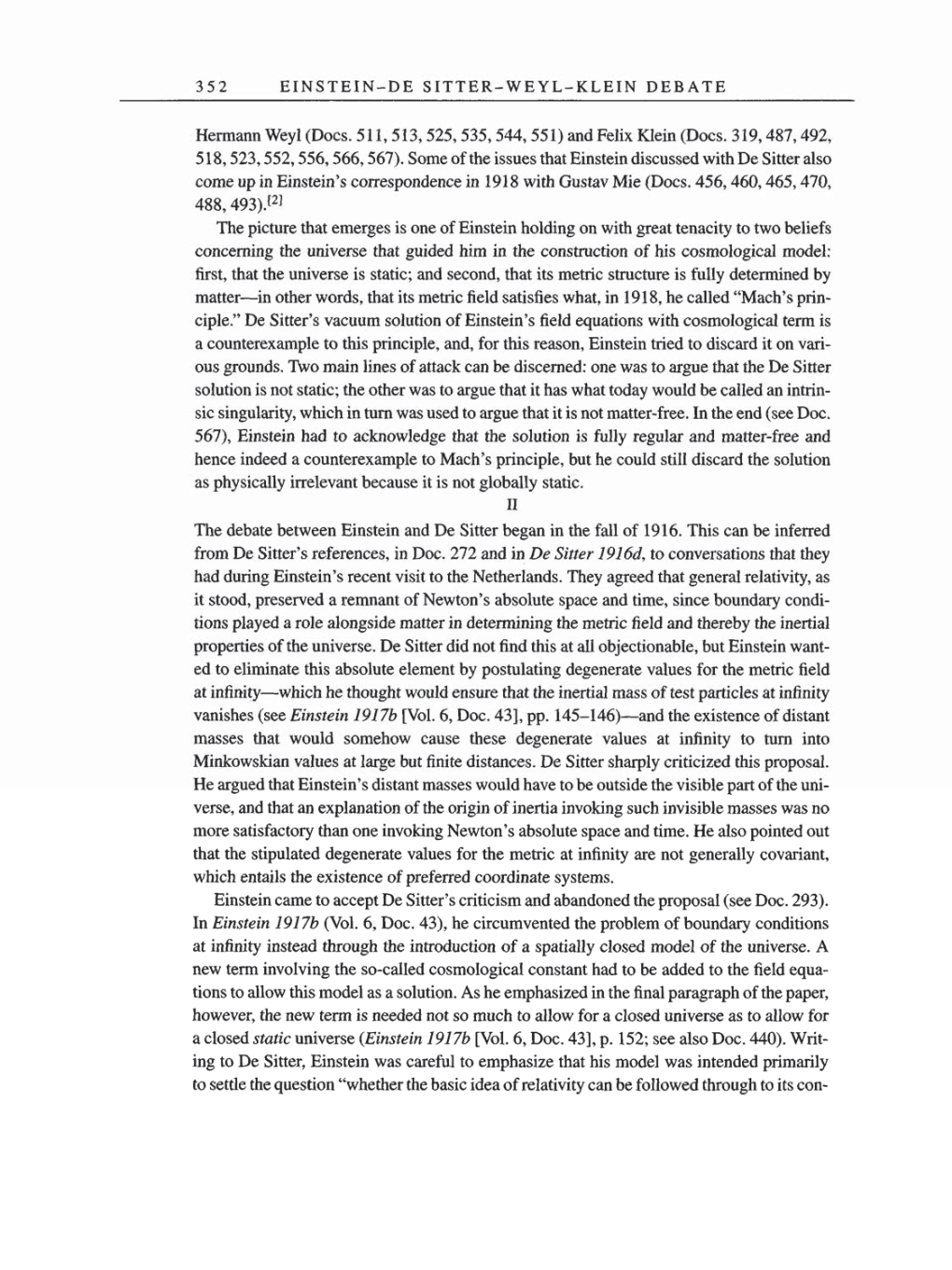352 EINSTEIN-DE SITTER-WEYL-KLEIN
DEBATE
Hermann
Weyl
(Docs. 511, 513, 525, 535,
544,
551)
and Felix Klein
(Docs. 319, 487, 492,
518, 523, 552, 556, 566, 567).
Some
of
the
issues
that
Einstein
discussed
with De Sitter also
come up
in Einstein’s
correspondence
in 1918 with Gustav Mie
(Docs.
456,
460, 465,
470,
488, 493).[2]
The
picture
that
emerges
is
one
of
Einstein
holding on
with
great tenacity
to two beliefs
concerning
the universe that
guided
him in
the
construction
of
his
cosmological
model:
first,
that
the universe is
static;
and
second,
that
its metric structure is
fully
determined
by
matter-in
other
words,
that its metric field satisfies
what,
in
1918,
he
called
“Mach’s
prin-
ciple.”
De Sitter’s
vacuum
solution
of
Einstein’s
field
equations
with
cosmological
term is
a counterexample
to this
principle,
and,
for this
reason,
Einstein tried
to discard it
on
vari-
ous grounds.
Two main
lines
of
attack
can
be discerned:
one was
to
argue
that the De Sitter
solution is not
static;
the
other
was
to
argue
that
it has what
today
would be called
an
intrin-
sic
singularity,
which
in turn
was
used to
argue
that
it is not matter-free. In the end
(see
Doc.
567),
Einstein had
to
acknowledge
that the solution is
fully
regular
and matter-free and
hence indeed
a
counterexample
to Mach’s
principle,
but he could still discard the solution
as physically
irrelevant
because
it is not
globally
static.
II
The
debate
between Einstein
and De
Sitter
began
in
the fall
of
1916. This
can
be inferred
from
De
Sitter’s references, in Doc. 272 and in
De Sitter
1916d,
to conversations that
they
had
during
Einstein’s recent
visit
to the Netherlands.
They agreed
that
general relativity, as
it
stood, preserved
a
remnant
of
Newton’s
absolute
space
and
time,
since
boundary
condi-
tions
played a
role
alongside
matter in
determining
the metric field and
thereby
the inertial
properties
of
the
universe. De Sitter did not find this at all
objectionable,
but Einstein want-
ed to eliminate this absolute element
by
postulating
degenerate
values
for
the metric field
at
infinity-which
he
thought
would
ensure
that
the inertial
mass
of
test
particles
at
infinity
vanishes
(see
Einstein 1917b
[Vol. 6,
Doc.
43],
pp.
145-146)-and
the
existence
of
distant
masses
that
would somehow
cause
these
degenerate
values at
infinity
to turn into
Minkowskian values at
large
but finite
distances. De Sitter
sharply
criticized
this
proposal.
He
argued
that Einstein’s distant
masses
would have to be outside the visible
part
of
the
uni-
verse,
and that
an explanation
of
the
origin
of
inertia
invoking
such invisible
masses was no
more satisfactory
than
one invoking
Newton’s absolute
space
and time. He also
pointed
out
that
the
stipulated degenerate
values for
the
metric at
infinity are
not
generally
covariant,
which entails the existence
of
preferred
coordinate
systems.
Einstein
came
to
accept
De Sitter’s
criticism
and abandoned the
proposal
(see
Doc.
293).
In Einstein 1917b
(Vol.
6,
Doc.
43),
he
circumvented
the
problem
of
boundary
conditions
at
infinity
instead
through
the introduction
of
a spatially
closed model
of the
universe.
A
new
term
involving
the
so-called
cosmological
constant had to be added to the field
equa-
tions to allow this model
as a
solution. As
he
emphasized
in the
final
paragraph
of
the
paper,
however,
the
new
term is needed not
so
much to
allow for
a
closed universe
as
to allow for
a
closed static universe
(Einstein
1917b
[Vol.
6,
Doc.
43],
p.
152;
see
also Doc.
440).
Writ-
ing
to De
Sitter,
Einstein
was
careful to
emphasize
that his model
was
intended
primarily
to settle the
question
“whether
the basic
idea of
relativity can
be followed
through
to
its
con—
